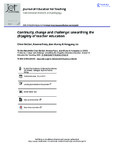Continuity, change and challenge: unearthing the (fr)agility of teacher education
| dc.contributor.author | McGarr, O | |
| dc.contributor.author | Passy, Rowena | |
| dc.contributor.author | Murray, J | |
| dc.contributor.author | Liu, H | |
| dc.date.accessioned | 2022-08-25T10:18:10Z | |
| dc.date.available | 2022-08-25T10:18:10Z | |
| dc.date.issued | 2022-07-19 | |
| dc.identifier.issn | 1360-0540 | |
| dc.identifier.issn | 1360-0540 | |
| dc.identifier.uri | http://hdl.handle.net/10026.1/19568 | |
| dc.description.abstract |
In this final article, we bring together the issues raised by authors included in this special issue. We start by describing the current situation in our own countries, partly to highlight the different ways in which nations are responding in the longer term to the pandemic, but also to draw attention to the similarity of experience–of educators using digital technology, of concern with maintaining the supply of teachers, of the challenges relating to lockdowns–during its peak. We then reflect on the systemic issues that have been raised by the authors in this issue: what we call the (fr)agility of the teacher education system, in which educators’ adaptive response to the pandemic and subsequent desire for change can be met by institutional resistance; the multiple questions raised by the use of digital technologies; and the challenges relating to teacher and teacher educator adaptability and/or agility. In the final section, we reflect on what we (might) have learned from the pandemic and consider a future agenda for teacher educators. | |
| dc.format.extent | 1-15 | |
| dc.language | en | |
| dc.language.iso | en | |
| dc.publisher | Taylor and Francis Group | |
| dc.subject | Covid-19 | |
| dc.subject | teacher education | |
| dc.subject | digital technology | |
| dc.subject | teacher agility | |
| dc.title | Continuity, change and challenge: unearthing the (fr)agility of teacher education | |
| dc.type | journal-article | |
| dc.type | Journal Article | |
| plymouth.author-url | https://www.webofscience.com/api/gateway?GWVersion=2&SrcApp=PARTNER_APP&SrcAuth=LinksAMR&KeyUT=WOS:000827962700001&DestLinkType=FullRecord&DestApp=ALL_WOS&UsrCustomerID=11bb513d99f797142bcfeffcc58ea008 | |
| plymouth.issue | 4 | |
| plymouth.volume | 48 | |
| plymouth.publication-status | Published | |
| plymouth.journal | Journal of Education for Teaching | |
| dc.identifier.doi | 10.1080/02607476.2022.2100249 | |
| plymouth.organisational-group | /Plymouth | |
| plymouth.organisational-group | /Plymouth/Faculty of Arts, Humanities and Business | |
| plymouth.organisational-group | /Plymouth/Faculty of Arts, Humanities and Business/Plymouth Institute of Education | |
| plymouth.organisational-group | /Plymouth/Research Groups | |
| plymouth.organisational-group | /Plymouth/Research Groups/Institute of Health and Community | |
| plymouth.organisational-group | /Plymouth/Users by role | |
| plymouth.organisational-group | /Plymouth/Users by role/Academics | |
| dcterms.dateAccepted | 2022-07-07 | |
| dc.rights.embargodate | 2022-8-26 | |
| dc.identifier.eissn | 1360-0540 | |
| dc.rights.embargoperiod | Not known | |
| rioxxterms.versionofrecord | 10.1080/02607476.2022.2100249 | |
| rioxxterms.licenseref.uri | http://www.rioxx.net/licenses/all-rights-reserved | |
| rioxxterms.type | Journal Article/Review |


